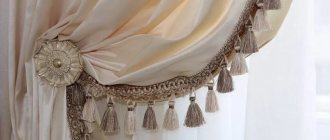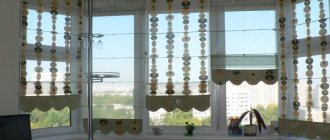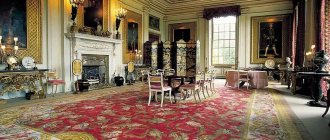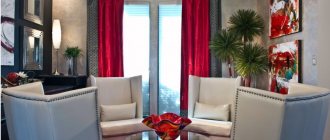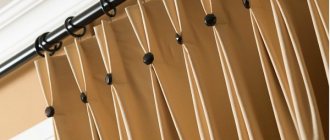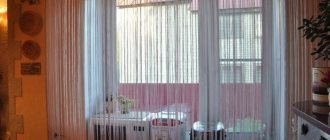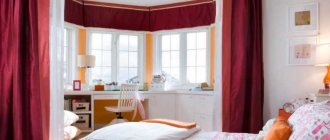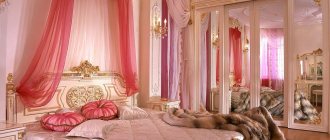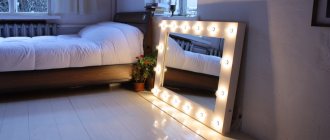The central part of any room is occupied by windows. It is their design that determines how the room looks as a whole - even if the emphasis in the interior is placed on a completely different detail.
The photo shows an interesting idea for a modern interior: a combination of a laconic rigid lambrequin and light voile curtains.
A rigid bandeau lambrequin will be a real find for those who want to change a room beyond recognition with one stroke, because with the help of this decorative element you can easily decorate... however, let's understand it in more detail!
Material
The fabric that will be used for the lambrequin should be combined with the curtain not only in color. The choice of material should be given special attention. Although the bandeau is an addition to the curtain, this decorative item should still stand out beautifully in the design of the window opening.
Guipure
A delicate lace ensemble will add lightness and make the design of the room unique.
Velvet
Velvet lambrequins will add luxury and nobility. The shade should match the mood in the interior and not overload the curtain. For example, such a fabric will go better with satin than with light tulle.
Jacquard
Current material, the main advantages are strength and durability. Thanks to the special weaving, a relief pattern is created, which makes the style impeccable.
Brocade
The lambrequin will look perfect in a room decorated in a classic style. Heavy silk textiles with a pattern of metallic threads look solemn and chic.
Satin fabric
Shiny and delicate material is associated with elegance and sophistication.
Product diagram
Before you start sewing or even making a pattern, draw, or better yet, draw to scale a diagram of your curtain with a rigid lambrequin. It will allow you to see how the element will look, and will also help when building a template according to size.
It is better to make the diagram on a scale of 1:10, when in 1 cm on the sheet you will have 10 cm of real ones. In this case, when creating a pattern, you can easily find out the length of any element.
Design options
Bandeaus for curtains have many different shapes; there are no restrictions on the implementation of the most daring idea. And most importantly, the decoration can be matched to any interior style.
Straight bandeau
It looks restrained and harmonious. Makes the space wider. A rectangular rigid lambrequin can be considered universal, as it is perfect for classic and modern styles. Combined with eyelet curtains for the finishing touch.
Made from two fabrics
The original method is a combination of several fabrics. The curtain looks more voluminous, the room takes on an elegant look.
Asymmetry
Material with a small pattern or patterns will look good. Curtains, on the contrary, should be plain and dim. In this combination, the bandeau will become a “highlight” in the interior. Often used for windows with balcony doors.
Geometry
Geometric shapes are more suitable for Greek or Roman style, and in a minimalist interior the decor will become a bright accent.
Openwork
The most elegant way to decorate a window opening. It will fit perfectly into the classic style and smooth out the strict look of the room in the high-tech style.
The original design is carried out in various ways: large cutouts will make the room richer, and an abundance of details will add grace.
There are two types of carved bandeau for curtains: figured (elements of different heights) and striped (a pattern repeated along the entire length).
Features of a rigid lambrequin
The second name of this popular and interesting decorative element is bandeau. Curtains with a rigid lambrequin are suitable for all types of windows and, as can be seen from the photo, will fit perfectly into any interior, creating an overall unique and stylish composition of the room.
Some people believe that a bandeau is only suitable for large rooms and rich, elaborate interiors, but this is not so. Modern design ideas and the use of lighter materials, both for the hardest base and for fabrics, make it possible to create neat, light and delicate options that are suitable for a small bedroom or kitchen. And if you add decorative textiles to the room itself, an explosive effect is simply guaranteed.
A rigid lambrequin has some features that distinguish it from other types of curtain decor:
- It has a solid base, most often made of wood or dense fabric;
- Sometimes, to add volume, it can be filled with padding polyester or holofiber (cotton wool was previously used, but recently, with the advent of more modern materials, it has ceased to be popular);
- It has arbitrary dimensions, but, as a rule, it is one fifth of the window - it can repeat its shape or be in the form of an arch;
- The edges of the bandeau can be smooth or made in any curly, symmetrical or asymmetrical shape;
- Design options are not limited - a rigid lambrequin can be either strict or decorated with various accessories - fringe, tassels, braid, cords, beads or bugles, etc.
A window with a rigid lambrequin looks impressive not only in the photo, but also in life.
Placement methods
The rigid lambrequin is attached to the cornice, so the surface must be flat. A ceiling structure is suitable for this. The bandeau can be placed in two ways.
Vertical
It is used infrequently; usually a lambrequin replaces one side curtain. Light tulle or organza is hung underneath it.
Horizontal
In this position, two types of gangs are attached:
- simple - for small windows. A minimum of decorative elements is used, the cornice is partially or completely closed;
- complex - for large rooms. The bandeau is complemented with lace, fringe, braid, drapery, etc.
What types of lambrequins are there?
Lambrequin is a horizontal strip of fabric that is attached over the curtains or to the cornice along its entire width. It can be perfectly smooth or with numerous different folds, drapery, fringe or tassels, etc. It can be sewn from the same fabric as the curtains themselves or completely different, but complementing the overall composition of the window. The length of the lambrequin varies, but usually it takes up one fifth of all curtains.
Typically, lambrequins are divided into the following types:
- Soft - as the name implies, it is sewn from soft fabrics that can easily be folded into a variety of flounces, folds, and drapery. All parts are sewn together and do not lose shape during use. One of the popular options for a soft lambrequin is “flip” - the fabric is folded and, as it were, wrapped in one or several waves around the cornice rod. Any type of soft lambrequin can be easily removed and washed even in a washing machine.
- Rigid – represents a rigid base onto which the fabric is stretched or glued. The edge can be either perfectly smooth or asymmetrical. He came to us from the distant Middle Ages, where he was very popular. Until now, rigid lambrequins, chic in their beauty, can be found when studying photos of the interiors of palaces and castles. This option looks very rich and stylish, but the disadvantage is that it cannot be removed for washing. Cleaning is possible only with a vacuum cleaner or a damp sponge.
- Combined - is a mixture of the first two types. To the rigid base you can add any number of additional details, flounces and folds from lighter fabric. Usually a soft lambrequin is placed on top of a hard one, but it can also peek out from under it.
Beautiful options for lambrequins
Any of these types can be additionally decorated with various fringes, braids, cords and other accessories. We invite you to look at photos of various options for different lambrequins.
Combination with different curtains
The window design will look harmonious if you combine the bandeau with curtains correctly.
Drapes and curtains
The fabric should be plain or with a contrasting pattern. You can combine materials of different textures: velvet and jacquard, satin and velor. An openwork bandeau for curtains would be an excellent option.
Roman
The color scheme should not differ much from the curtain. This option is suitable for Provence or high-tech style.
Blinds
A popular modern combination that fits perfectly into the kitchen design. Bandos should be chosen in a restrained color, and blinds with bright motifs.
Patterns: we make them ourselves and use ready-made ones
To sew a rigid lambrequin with your own hands, you will need a template from which to cut out the parts from the gang.
If you are going to make a lambrequin of a simple shape, it is easier to create a pattern yourself on a 1:1 scale.
It makes sense to use ready-made options in case of repetitions of some module or a very complex asymmetrical shape, which, due to lack of skills, cannot be drawn by yourself.
If you decide to make the pattern yourself, prepare the following materials:
- a long strip of paper corresponding to the size of the lambrequin. You can use unnecessary wallpaper, graph paper, whatman paper, glue together a format from office printer paper or newspapers. The last option is not very good, since the paper is too thin, and using the template you will have to trace the outline of the product on the gang.
- pencil;
- ruler;
- square;
- a compass if you will have arcs or semicircles;
- scissors or knife.
You need to build a pattern like this:
- Draw a rectangle corresponding to the maximum dimensions of the lambrequin in width and height, respectively.
- Construct an axis of symmetry if the shape is like this.
- From the completed center line, set aside the required distances to the left and right and line up the figures.
If you have previously made a diagram to scale, then you can simply measure from the lower left corner the lengths that you take from the diagram, multiplied by the scale factor. For example, on your sketch you have 3cm, with a scale of 1:10 on the pattern it will be 30cm.
If your bottom edge is made in the form of repeating shaped modules, it’s enough to build one on another sheet, and here just circle it several times.
Having mastered the creation of patterns for rigid lambrequins, you will be able to make templates of any complexity yourself. You won't have to look through a lot of images on the Internet, wasting your time. An idea appeared, they took it and implemented it, first in the pattern, then in the material.
Bandeau in different styles
Classic
This style is characterized by luxury and elegance. They use noble fabrics: velvet, brocade, delicate satin. Can be enriched with various accessories.
Provence
The style is filled with lightness and comfort. You should not use something pretentious and bulky. The product should be of a simple shape, with floral prints or small patterns. These bandeau curtains are suitable for the bedroom.
Minimalism
Lambrequins should be laconic, use fewer accessories and decor.
East style
Rich fabrics are used: silk, velvet, satin. Bandeaus in this style are decorated with tassels or fringes, and there are various abstract patterns or hieroglyphs.
How to make a rigid lambrequin with your own hands
According to the method of sewing, lambrequins are divided into complex and simple.
To decorate the lambrequin you will need beads.
The first combine soft and hard types. These combinations are often made from softer materials. When selecting ready-made purchased products for pre-sewn curtains, you should pay special attention to the main color of the curtain material.
If you start learning how to sew hard-type lambrequins, then first it is better to make one for the kitchen. This will not require the invention of special patterns for a specific design. Decorating a window with a rigid type of lambrequin called a gang will be ideal for any room, from a nursery to a study.
The decoration of the products is fringe, cords or flowers from different fabrics. To make it yourself, you will need the following tools and materials:
- The finished bandeau base is 45 cm wide, you can use adhesive tape.
- Iron.
- Decorative finishing.
- Sewing machine.
- Scissors.
- The tape is sticky.
Care
A rigid lambrequin can last a long time if you follow simple care rules:
- Washing is prohibited as the product will lose its shape.
- Hand washing of individual parts is allowed.
- It is recommended to periodically vacuum the bandeau using a soft nozzle.
- If it is heavily soiled, you can wipe it with a damp cloth or contact a specialist.
Lambrequin on a solid base
If the density of a solid lambrequin is not enough, then as a base you can choose not adhesive material, but thin plywood with a thickness of no more than 2 mm. In this case, all actions to cover the base with material will be performed using a construction stapler. At the same time, during production you can also use various fabrics and decorations, which are stitched and sewn to the base material before covering the plywood with it. And in order for the rigid lambrequin to look more voluminous, thin foam rubber must be glued to that part of the plywood blank that will serve as the basis for the front curtain fabric.
Having carefully studied these instructions, the question of how to sew a rigid lambrequin will no longer arise. And every housewife who has at least a little experience in cutting and sewing can quickly do it on her own, paying sufficient attention to the clarity and accuracy of edge processing to achieve a high-quality result. At the same time, she will receive maximum pleasure from the work done and will complement the interior of the rooms in her home and the beautiful curtains themselves with an exclusive decorative element.
Self-tailoring
Often the product is sewn to order, but at home you can also make a bandeau for curtains with your own hands.
In a specialized place, you need to purchase a pro bandeau or use adhesive material for sewing (non-woven fabric or dublerin). A rigid lambrequin is created according to the following scheme:
- Choose a plain, dense fabric.
- Measure the width of the window opening and add 3-4 cm on each side to stitch.
- Make a pattern on paper (newspaper or wallpaper).
- Transfer the pattern to a rigid base.
- Place the fabric on the adhesive surface and smooth it with an iron.
- Finish the edge (with decorative braid or hemming).
- Attach the finished product to the cornice using adhesive tape.
Changing the proportions and appearance of the window
The photo shows a rigid lambrequin for curtains, decorated with fabric to match the curtains. This creates a harmonious image of the window.
Unfortunately, the shape and size of the window do not always correspond to the desired ones. However, a rigid lambrequin can come to the rescue in this difficult situation.
What you think is a small window can be visually enlarged with a lambrequin with elongated sides covering the opening.
For wide windows, bandeaus with a curved edge rather than a straight one are best suited.
Changing the shape of a window is quite simple. It is easy to turn a rectangular opening into an oval one by choosing the semicircular shape of a rigid lambrequin.
Accordingly, in order to give an oval window a square shape, preference will have to be given to an accessory with a strict geometric shape.
Photo of a bandeau for curtains
Share with friends:
Soft forms of drapery
Coquille
The mold is a textile component laid out in the form of vertical folds converging towards the center of the composition. The assemblies are located towards each other, in opposite directions. According to the style of cut, they distinguish between a cut mold and a classic type. Sometimes the mold is decorated with small accessories.
Swag
Swag is when a part is laid in flexible wavy arcs (sags) and assembled in beautiful folds, horizontal or vertical. The assembly can be symmetrical or asymmetrical.
Jabot
Jabot - vertical lateral sags - “tails”, collected in folds, the edge of the part is beveled. De jabot elements outline the outermost vertical frames of the window opening.
Perekid (semi-swag)
A perekid (half-wag) is formed when the panel is thrown over the cornice, and sagging drapery elements are formed. Looks good on tubular crossbars and in compositions on baguette cornices.
Tie
- Fashionable curtains for the kitchen: new design options for curtains for the kitchen
Curtains for the living room in a modern style: real design examples (100+ photos)
The best modern night curtains for the hall (60+ photos)
The tie is similar to a de jabot, but has a spiral drapery, which is used to decorate the edges and spaces between the swags. Often hung on the windows of classic interiors.
